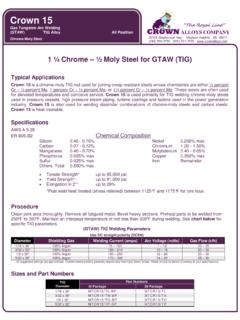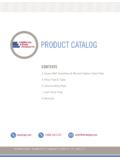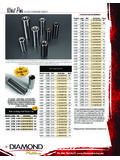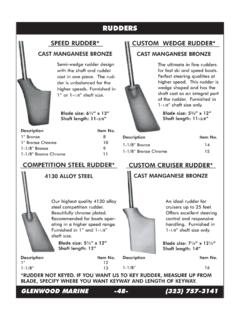Transcription of STATE OF THE ART WORK ROLLS FOR HOT ROLLING FLAT …
1 CONAC 2007 3rd steel Industry Conference and Exposition - 1 11th to 14th November, 2007 - Centro Convex, Monterrey, , M xico STATE OF THE ART WORK ROLLS FOR HOT ROLLING flat PRODUCTS Karl Heinz Ziehenberger Development Engineer - ESW, AUSTRIA Michael Windhager Head of R & D - ESW, AUSTRIA Key words: ICDP, High Chrome, HSS, hot strip mill, CSP mill, Steckel mill ABSTRACT STATE of the art work roll grades for roughing and finishing mill application are described, including characterisation of microstructure, hardness and residual stress levels.
2 Most recent work roll developments are presented, including results of HSS ROLLS running successfully in roughing and finishing stands of conventional HSM as well as CSP-mills; HSS developments for Steckel mills are discussed in detail. ROLL TYPES AND ALLOYING SYSTEMS Over the last years, the use of work ROLLS for hot ROLLING of flat steel has changed. The following picture gives a short description of the recent history of roll grades development in a conventional hot strip mill (fig. 1). In the roughing stands, conventional high chrome steel 70 75 ShC has been gradually replaced by new grades like carbide enhanced high chrome steel 75 80 ShC, ultra low carbon grades like Semi HSS resp.
3 Matrix type HSS 80 90 ShC, Konkordia (= Cr-based HSS) and the variety of other HSS grades HSS 75 85 ShC. Due to roll size and production demands placed on the rougher ROLLS , these developments follow mainly the first finishing stands F1-F4. The first 3 4 finishing stands have seen a development from high chrome cast iron 70 75 ShC to carbide enhanced high chrome cast iron 75 80 ShC, Konkordia 75 85 ShC (Chrome based HSS), and a variety of other HSS grades 75 85 ShC. CONAC 2007 3rd steel Industry Conference and Exposition - 2 11th to 14th November, 2007 - Centro Convex, Monterrey, , M xico In the last finishing stands the situation is quite different.
4 Conventional ICDP ROLLS 70 85 ShC which had been used over decades, are now being largely replaced by carbide enhanced ICDP ROLLS of different alloying concepts and performance as well as safety levels. Graphite containing high chrome cast iron ROLLS and roll grades with no graphite in the shell are being used in some places, but more or less on a trial scale. Figure 1: work roll types for hot ROLLING of flat products The driving force for all these developments was the idea of improving the wear resistance and surface quality of the ROLLS in order to run much longer campaigns and to improve the efficiency of the entire mill (or at least maintain a certain campaign length, but ROLLING thinner gauges and harder steel grades).
5 Not all ideas and concepts of improving the shell material could be realised, some of them failed in mill trials. The reason is quite simple (fig. 2): - Double poured work ROLLS are big and very complex castings. The bigger the casting, the more likely the inner part of the casting will show smaller (or bigger) imperfections - Shell and core material have different alloying contents, transformation temperatures and thermal expansion. This leads to high residual stress (compression stress in the shell, tensile stress in the core) - High residual stress and imperfections in the inner part of the shell or in the transition zone shell core may increase the risk of roll failure CONAC 2007 3rd steel Industry Conference and Exposition - 3 11th to 14th November, 2007 - Centro Convex, Monterrey, , M xico Figure 2.
6 Principle of compound ROLLS [1] The development of shell materials and roll grades over the last years can be described as follows (fig. 3): We can see a development starting from clear chill ROLLS to indefinite chill, then (after a long time) came high chrome iron and high chrome steel grades, which later were modified by carbide enhancement. After that we saw the development of HSS (beginning in the first finishing stands) and ultra low carbon grades (for the roughers). This sequence of roll grades was characterized by a steady improvement of tonnage performance, although the hardness of the ROLLS did not change drastically.
7 Even more astonishing is the fact that the total carbide content of the roll shell materials decreased from around as much as 40% (clear chill and high hardness indefinite chill with low graphite content) to 5 15% only (in case of HSS). Ultra low carbon grades like Semi HSS may even show carbide contents below 5%. So where did the performance improvements come from??? CONAC 2007 3rd steel Industry Conference and Exposition - 4 11th to 14th November, 2007 - Centro Convex, Monterrey, , M xico Figure 3: roll grades for hot ROLLING of flat products [2, 3] It would be wrong to say that the big improvement of performance of modern roll types came from the new ROLLS only.
8 The terrific improvements made in the hot ROLLING mills, efforts in automatization and planning of campaigns as well as introduction of newly developed lubricants and new testing and grinding practices in the roll shops have also played a major role. But it cannot be denied that also the roll makers have been successful in their efforts to improve their products. In modern ROLLS , the carbide types and carbide hardness have changed totally. We can distinguish between 4 different systems of shell microstructures: - Clear chill and conventional ICDP and, with small variations concerning carbide types and graphite formation, also carbide enhanced ICDP - High chrome iron and steel and, again with small variations in the carbides, the carbide enhanced types - All variations of HSS - Ultra low carbon grades When we now have a look at the performance levels of different roll types used in roughing and finish ROLLING , we can STATE that.
9 - staying within the same system of shell microstructure, changing hardness of high chrome or using carbide enhanced high chrome instead of conventional high chrome, will certainly increase roll performance and surface quality at least to some extent. - Drastic increase of performance can only be reached by leaving the system and going for an advanced roll type. CONAC 2007 3rd steel Industry Conference and Exposition - 5 11th to 14th November, 2007 - Centro Convex, Monterrey, , M xico Here are some examples of ESW s customers to describe the situation we can see in many hot ROLLING mills.
10 Example 1: SINGLE REVERSING ROUGHER WR 1250x2050 mm of a semi-continuous HSM ROLLING mainly carbon grades (fig. 4) With conventional high chrome steel ROLLS 70 75 ShC, the campaign length was limited to an average of tons. Carbide enhancement and an increase in hardness to 75 80 ShC helped to increase the campaign length to tons. In addition to that, an increase in surface quality could be observed see fig. 5 illustrating the comparison in surface roughness. A major increase in campaign length could be reached by moving towards HSS roll grades.





